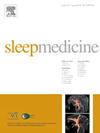Midday napping duration and risk of stroke: A prospective study in China
IF 3.8
2区 医学
Q1 CLINICAL NEUROLOGY
引用次数: 0
Abstract
Background
Evidence on the potential effects of midday napping on risk of stroke in Chinese populations remains limited.
Objectives
We aimed to prospectively investigate the association between midday napping and risk of subsequent stroke and stroke subtypes in the Kailuan study.
Methods
Midday napping duration was obtained from a self-reported questionnaire. Incident stroke cases from baseline (2014) to December 31, 2020 were confirmed by review of medical records. The association of midday napping duration with risk of incident stroke and subtypes was examined using a Cox regression model, adjusting for potential confounders. We further investigated the joint effects of nocturnal sleep duration and midday napping on the risk of stroke.
Results
A total of 96,899 individuals (21.0 % women; 51.9 ± 14.0 years) were included. During an average follow-up of 5.62 ± 0.69 years, 2539 incident stroke cases were documented. After adjusting for potential confounders, we found that participants with a midday napping duration of >60 min/day had higher risk of incident stroke (adjusted HR: 1.23; 95 % CI: 1.07, 1.42), compared with those without midday napping. Furthermore, significant joint effects were found in both nocturnal sleep duration (P-interaction=0.04) and snoring status (P-interaction= 0.005) on the association between midday napping duration and the risk of incident stroke, especially for participants who napped >60 min/day and slept ≤7 h/night compared with those who slept 7–8 h/night and did not take a nap, or those who napped >60 min/day and snored compared with those who did not take a nap and snore.
Conclusions
We found that prolonged midday napping (>60 min/day) was associated with higher risk of stroke and the association was stronger among those with shorter nocturnal sleep duration or those who snored.
午睡时间与中风风险:中国的一项前瞻性研究。
背景:关于午睡对中国人群中风风险潜在影响的证据仍然有限。目的:在开滦研究中,我们旨在前瞻性地研究午睡与随后中风和中风亚型风险之间的关系。方法:采用自述问卷获取午睡时间。从基线(2014年)到2020年12月31日的突发中风病例通过审查医疗记录得到确认。利用Cox回归模型对潜在混杂因素进行校正,检验午睡时间与卒中发生风险和亚型之间的关系。我们进一步调查了夜间睡眠时间和午睡对中风风险的共同影响。结果:共96,899人(21.0%为女性;51.9±14.0岁)。在平均5.62±0.69年的随访期间,记录了2539例突发中风病例。在调整了潜在的混杂因素后,我们发现午睡时间为每天60分钟的参与者发生中风的风险更高(调整后的风险比:1.23;95% CI: 1.07, 1.42),与不午睡的人相比。此外,夜间睡眠时间(P-interaction=0.04)和打鼾状态(P-interaction= 0.005)在午间小睡时间与卒中发生风险之间的关联上发现了显著的联合效应,特别是那些每天小睡60分钟,睡眠≤7小时/夜的参与者与那些睡7-8小时/夜且不午睡的参与者相比,或者那些每天小睡60分钟,打鼾的参与者与那些不午睡和打鼾的参与者相比。结论:我们发现,午睡时间过长(每天60分钟)与中风风险升高相关,且这种关联在夜间睡眠时间较短或打鼾的人群中更为明显。
本文章由计算机程序翻译,如有差异,请以英文原文为准。
求助全文
约1分钟内获得全文
求助全文
来源期刊

Sleep medicine
医学-临床神经学
CiteScore
8.40
自引率
6.20%
发文量
1060
审稿时长
49 days
期刊介绍:
Sleep Medicine aims to be a journal no one involved in clinical sleep medicine can do without.
A journal primarily focussing on the human aspects of sleep, integrating the various disciplines that are involved in sleep medicine: neurology, clinical neurophysiology, internal medicine (particularly pulmonology and cardiology), psychology, psychiatry, sleep technology, pediatrics, neurosurgery, otorhinolaryngology, and dentistry.
The journal publishes the following types of articles: Reviews (also intended as a way to bridge the gap between basic sleep research and clinical relevance); Original Research Articles; Full-length articles; Brief communications; Controversies; Case reports; Letters to the Editor; Journal search and commentaries; Book reviews; Meeting announcements; Listing of relevant organisations plus web sites.
 求助内容:
求助内容: 应助结果提醒方式:
应助结果提醒方式:


